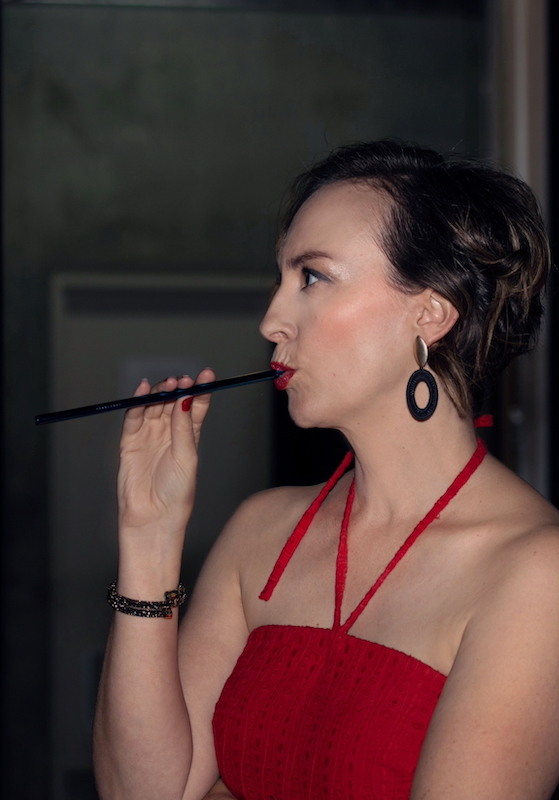A strong, clear voice for singing or speaking performances can come naturally for some people, whilst others may enhance their voice through vocal coaching and training. For all voice users it’s important to practise healthy voice habits to maintain the quality of your voice. If your vocal folds become strained, it can affect the strength and sound of your voice over the long term. This is where SOVT training exercises can help.

If you’re looking for an effective way to warm up, cool down, keep the vocal folds vibrating efficiently, and to release tension, then semi occluded vocal tract exercises (SOVT) may help. Performing SOVT exercises, such as straw therapy, can help relax your vocal tract, assist recovery and improve the sound of your voice. They’re simple and can make a big difference in your performance.
Call Now To Make An Appointment
Jenny is a Certified Practising Speech Pathologist, in Brisbane, with a special interest in voice.
What are SOVT Vocal Exercises?
SOVT training is most often used by singers to improve and help maintain the voice. But it can also be very helpful if you rely on having an optimal voice for speaking at work or in your personal life. SOVT voice therapy has been shown to increase mean air flow and sound pressure level resulting in the vocal folds vibrating more efficiently.
These exercises are referred to as semi-occluded because you perform them with your vocal tube partially blocked off. There are several different versions of this. You can hum, which closes your mouth and directs air and sound through the nose, lengthening the vocal tube. Another version is to make trill sounds through pursed lips, which also creates a narrower opening.
Different Types of SOVT
SOVT training can be adapted to your needs and your current abilities. If you have a voice injury or are mostly untrained, you can perform less complex exercises, matching your current abilities. This could be as simple as singing or speaking a single note or word.
Experienced singers or speakers can further enhance their voice by doing a range of exercises during semi occluded vocal tract training. These could include complicated scales or even singing an entire song through a straw. The addition of a straw therapy cup may increase the improvement gained even further.
Whilst using the above techniques it’s possible to practise sounds, give a speech, repeat a single note, run through basic scales and even laugh. Your speech therapist can assist you with knowing which exercises are most likely to be beneficial in your situation and how you can implement them to enhance your voice.
Some common SOVT exercises include:
- Humming
- Straw therapy using straws of different lengths and diametres
- Straw and cup therapy
- Lip or tongue trills
- Practicing rounded lip vowels
One of the most helpful SOVT exercises is to put a straw in your mouth while making an ‘oo’ sound, speaking, or singing through it.
This partially blocks off your vocal tube, creating a narrow opening for the air to flow through and elongating your vocal tract. These exercises have a variety of names including straw singing, straw phonation, and vocal straw exercises, but they all mean the same thing.

Using speech therapy straws is a great way to practice pitch glides, speeches, and songs that require the optimal vocal fold position. They will also help repair and protect your voice if you’ve injured it in some way. And they can help you achieve your vocal goals without causing additional stress or strain for your vocal folds or voice.
How Does Straw Therapy Work?
SOVT training with straws encourages a variety of changes in your body and in the way you create sound, all of which benefit your vocal folds. SOVT training helps to release tension of the false vocal folds and improve the efficiency of how the true vocal folds come together and produce a clear sound. For tired vocal fold SOVT exercises encourage relaxation and recovery without causing undue strain.
These exercises can also help to:
- Engage the respiratory muscles
- Square up and coordinate the way the vocal folds come together and vibrate
- Enlarge the throat or pharynx to create more space for the sounds to bounce off
- Reduce the amount of tension needed to make the vocal folds vibrate and produce sound
- Reduce vocal fold fatigue
- ‘Iron out’ any crackles or pitch breaks at the upper and lower ends of your pitch range
Some of the most important benefits of these exercises are:
Relaxation
First and foremost, SOVT exercises are gentle and relaxing for the vocal folds. Speaking or singing with a straw in your mouth keeps your mouth partially closed while you create sound. This elongates the vocal tract and reflects tiny back pressures into the straw and down the vocal tract. These tiny pressures help to release and unload any tension in the vocal folds.

Optimal Positioning
Secondly, these straw therapy exercises encourage the vocal folds to elongate and move into an optimal position for creating sound. This helps to train them, so they naturally assume the same position when you use your voice without a straw.
Call Now To Make An Appointment
Jenny is a Certified Practising Speech Pathologist, in Brisbane, with a special interest in voice.
Decreased Vocal Cord Workload
And finally, these exercises decrease the vocal cord workload, allowing them to focus on the task of singing or speaking. Usually, while you sing your vocal folds are also resisting the push of air pressure from the lungs.
When you do SOVT exercises, air builds up in the oral cavity because your mouth is mostly closed. This air presses back against the air pressure from the lungs and without that extra workload, your vocal folds can function more efficiently.
Tips for SOVT Training
To perform SOVT voice therapy with straws correctly, you should see a vocal coach first to ensure that you’re doing the right exercises for your needs. However, here are some tips that should help you perform these exercises correctly:
- Practice regularly, in short sessions, for the best results
- Try to breathe normally and not through the straw
- Hold your nose to ensure that the air is flowing out through the straw
- Relax your face and neck muscles
- Choose exercises based on your personal voice goals
Following these tips will help you get the most from your SOVT training and help you avoid injuries and strain.
The Takeaway
Whether you’re a singer, a teacher, a salesperson, or a public speaker, your voice is a great tool. That’s why you need to keep it in good shape. With SOVT training and other similar exercises you can help achieve this.
SOVT voice therapy is gentle, relaxing, and can encourage your vocal folds to work together in the most optimal way. For more help with improving the sound or performance of your voice or to overcome strain or damage, contact Jenny Matthews.




